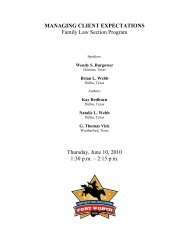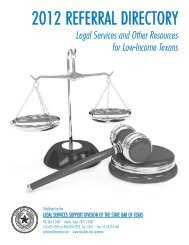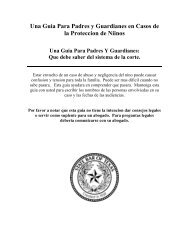Resources for Lawyers Assisting Veterans - State Bar of Texas
Resources for Lawyers Assisting Veterans - State Bar of Texas
Resources for Lawyers Assisting Veterans - State Bar of Texas
You also want an ePaper? Increase the reach of your titles
YUMPU automatically turns print PDFs into web optimized ePapers that Google loves.
RESOURCES FORLAWYERSASSISTING VETERANS
<strong>Texas</strong> Young <strong>Lawyers</strong> AssociationCommunity Education and Consumer Affairs CommitteeP.O. Box 12487, Capitol StationAustin, TX 78711-2487(800) 204-2222 Ext. 1800Produced as a public service by the<strong>Texas</strong> Young <strong>Lawyers</strong> Association.Please note that this brochure is solely intended to provide generalin<strong>for</strong>mation only and is not to be interpreted as legal advice. It is notintended to be an exhaustive treatise on these areas <strong>of</strong> law; rather, you,as a lawyer, will likely need to investigate these legal issues further. Anylaws described in this pamphlet are subject to change at any time.
INTRODUCTION“The willingness with which our young people are likely to serve in any war, no matterhow justified, shall be directly proportional to how they perceive the <strong>Veterans</strong> <strong>of</strong> earlierwars were treated and appreciated by their nation.”These words ring just as true today as they did in 1781 when George Washingtonproclaimed them. As lawyers, we are in a unique position to assist our nation’s veteranswho have served our country in the past, as well as those who are now returninghome from war, who face a number <strong>of</strong> legal challenges arising from their service toour country.This pamphlet, a publication <strong>of</strong> the <strong>Texas</strong> Young <strong>Lawyers</strong> Association (TYLA)and <strong>Texas</strong> <strong>Lawyers</strong> <strong>for</strong> <strong>Texas</strong> <strong>Veterans</strong>, is intended to summarize legal issues faced byour veterans and resources <strong>for</strong> lawyers assisting veterans. In this pamphlet, you willfind in<strong>for</strong>mation about the following:• Common Legal Issues Facing <strong>Veterans</strong>• <strong>Assisting</strong> <strong>Veterans</strong> with Benefits Claims, Denials, and Appeals• Mental Health Issues Faced by <strong>Veterans</strong>• <strong>Resources</strong> <strong>for</strong> <strong>Lawyers</strong> <strong>Assisting</strong> <strong>Veterans</strong><strong>Texas</strong> <strong>Lawyers</strong> <strong>for</strong> <strong>Texas</strong> <strong>Veterans</strong> is a <strong>State</strong> <strong>Bar</strong> <strong>of</strong> <strong>Texas</strong> program developed to assistpro bono legal clinics throughout the state <strong>for</strong> military veterans. You can find links to anumber <strong>of</strong> resources on the <strong>State</strong> <strong>Bar</strong> <strong>of</strong> <strong>Texas</strong>’ website: www.texasbar.com/veterans.TYLA and <strong>Texas</strong> <strong>Lawyers</strong> <strong>for</strong> <strong>Texas</strong> <strong>Veterans</strong> have also published a companionto this pamphlet, <strong>Texas</strong> <strong>Lawyers</strong> <strong>for</strong> <strong>Texas</strong> <strong>Veterans</strong>: <strong>Resources</strong> <strong>for</strong> <strong>Veterans</strong> Seeking Help(www.texasbar.com/tylaveteransresourcespamphlet), which is intended <strong>for</strong> use byveterans. It explains the need <strong>for</strong> representation by an attorney, and identifies anddescribes useful legal resources. The companion pamphlet also contains in<strong>for</strong>mationregarding non-legal issues helpful to veterans, including education, employment,financial assistance, and health care.1
COMMON LEGAL ISSUES FACING VETERANSThis section provides summary in<strong>for</strong>mation regarding some <strong>of</strong> the legal issuesmost commonly faced by veterans. You will find that in addition to disability andretirement benefits issues, veterans face many <strong>of</strong> the same issues as any other client.Common legal areas you may be called upon to address include:• Bankruptcy• Consumer Protection• Family Law• Probate Law• Property LawAlthough this pamphlet focuses on veterans, there are several state and federalstatutes that protect servicemembers. In the event you are asked questions about ouractive duty military, you should be aware <strong>of</strong> the Servicemembers Civil Relief Act(SCRA) (50 U.S.C.A. § 510 et. seq.).To view the full text <strong>of</strong> the SCRA, visit:www.uscg.mil/legal/la/Legal_Assistance_doc/getdoc.pdfAdditionally, consult TYLA’s Servicemember Civil Relief Act pamphlet:www.tyla.org/tasks/sites/default/assets/File/08ServicememberCivilReliefActBro.pdfBANKRUPTCYBankruptcy is a process that allows individuals and families to discharge orreorganize the debts they owe to their creditors. There are five types, or chapters, <strong>of</strong>bankruptcy — Chapters 7, 9, 11, 12, and 13. Consumers typically file Chapter 7 or13. It is important to speak to an attorney familiar with bankruptcy law be<strong>for</strong>e filing, orassisting someone in filing, a bankruptcy petition.In both Chapters 7 and 13, a debtor is entitled to receive a discharge <strong>of</strong> all debtsexcept those debts incurred by fraud, embezzlement, larceny, domestic supportobligation, willful or malicious injury to the property <strong>of</strong> another entity, death or personalinjury caused by the debtor’s operation <strong>of</strong> a motor vehicle while intoxicated, orthe debtor’s failure to pay restitution under certain criminal restitution orders. Aneducational loan may not be discharged unless the debt imposes an undue hardship.2
Chapter 7 BankruptcyChapter 7 creates an estate to preserve and liquidate the non-exempt assets <strong>of</strong>the debtor in an orderly way. The debtor must receive credit counseling prior to filing abankruptcy petition. A trustee is appointed by the U.S. Trustee’s <strong>of</strong>fice after Chapter 7papers are filed with the court. The trustee investigates the financial affairs <strong>of</strong> thedebtor and takes control <strong>of</strong> the non-exempt property within the debtor’s estate afterthe case is filed. The trustee’s role in the case is to collect and liquidate property <strong>of</strong> theestate and distribute any cash to creditors. After the trustee investigates the circumstancethat led to the debtor’s insolvency, the debtor is <strong>for</strong>given <strong>of</strong> his or her debts. Thedebtor’s creditors are paid from the non-exempt assets <strong>of</strong> the bankruptcy estate.Under certain income rules, a debtor may not file a petition under Chapter 7 ifhis or her relative income exceeds the state median income <strong>for</strong> an individual taxpayeror that <strong>of</strong> a family <strong>of</strong> two, three, or four family members within the <strong>State</strong> <strong>of</strong> <strong>Texas</strong>.If these rules apply to the debtor, a presumption <strong>of</strong> abuse occurs, which must berebutted by the debtor. If the debtor fails to rebut the presumption, the debtor willbe required to file a case under Chapter 13.Chapter 7 cases typically last 60 to 90 days unless the trustee uncovers fraud or acreditor files an objection to discharge in the case. If a debtor transfers property withintwo years <strong>of</strong> the date <strong>of</strong> filing his or her case, the trustee may void such transfer. If thedebtor made the transfer with the actual intent to hinder, delay, or defraud creditors,a creditor or trustee may ask the court to revoke the debtor’s Chapter 7 discharge.Chapter 13 BankruptcyChapter 13 creates an estate to allow wage earners to discharge their pre-petitiondebts. The debtor may propose a plan to repay his or her debts over a period <strong>of</strong> threeto five years. However, the debtor must commit all <strong>of</strong> his or her projected disposableincome under the plan, and the plan repayment period may not exceed five years.The debtor must also receive credit counseling prior to filing a Chapter 13 bankruptcypetition. To qualify <strong>for</strong> Chapter 13, an individual debtor’s unsecured debts may notexceed $336,900 and his or her secured debts must be less than $1,010,650.In Chapter 13, the trustee mainly collects payments made under a planapproved by the court, and then uses that money to pay <strong>of</strong>f part <strong>of</strong> the debts. Thereis an “automatic stay” which prevents creditors from collecting on debts owed at thetime the bankruptcy case was filed. However, creditors in both chapters can file3
pro<strong>of</strong>s <strong>of</strong> claim to try to receive payment <strong>for</strong> some <strong>of</strong> the money they are owed bythe trustee, and they can take other actions with court permission to protect their interestsand attempt to receive payment. The debtor’s income affects the amount each creditoris entitled to receive by extending the length <strong>of</strong> a proposed plan <strong>of</strong> reorganization.Under certain rules, if the debtor’s income falls below the median state income taxguidelines, the plan may not exceed three years. Similarly, if the debtor’s incomeexceeds the median state income tax guidelines, the plan cannot be less than five years.Unlike Chapter 7, the debtor is allowed to bring pre-bankruptcy mortgage paymentscurrent over a period <strong>of</strong> time. However, the debtor must pay each <strong>of</strong> his or herpost-bankruptcy mortgage payments as it comes due. The nature <strong>of</strong> the debtor’sexempt property varies by jurisdiction and by state but typically includes a portion<strong>of</strong> the equity in the debtor’s primary residence as well as other personal items. Thedebtor will retain possession <strong>of</strong> his or her property so long as all projected disposableincome is paid to creditors <strong>for</strong> the duration <strong>of</strong> the plan.Exempt PropertyAll property considered “exempt” can be maintained under Chapter 7 or 13bankruptcies. There are two different sets <strong>of</strong> property considered “exempt” — federaland state. The <strong>Texas</strong> exemptions allow a family to keep a homestead, no matter thevalue, and up to $60,000 ($30,000 per individual) <strong>of</strong> certain personal property.<strong>Texas</strong> Property Code Chapters 41 through 44 contain details regarding propertyexempt from claims, with Sections 42.001 and 42.002 containing the specific list <strong>of</strong>exempt personal property. Property that is not normally exempt is land other thanthe homestead, extra cars, boats, four wheelers, cash, or money in a checking orsavings account.For more in<strong>for</strong>mation on consumer bankruptcies, consult the following reference:<strong>State</strong> <strong>Bar</strong> <strong>of</strong> <strong>Texas</strong> Bankruptcy Sectionwww.txbankruptcylawsection.comTYLA’s Consumer Bankruptcywww.tyla.org/tasks/sites/default/assets/File/37475BankruptcyBookletLoRes.pdfCONSUMER PROTECTIONYou may find that a veteran, as with any client, has been taken advantage <strong>of</strong> byanother person through fraud or dishonest practices. As such, it is helpful to be aware4
<strong>of</strong> the Deceptive Trade Practices Act (DTPA), the Residential Construction LiabilityAct (RCLA), and the <strong>Texas</strong> Debt Collection Act.DTPAThe DTPA is found at § 17.41 et seq. <strong>of</strong> the <strong>Texas</strong> Business and Commerce Code.It provides what is referred to as the “laundry list” <strong>of</strong> actionable wrongful acts, such asmisrepresenting the quality <strong>of</strong> goods or services, misrepresenting rights in an agreement,and about two dozen others. The DTPA requires that the opposing party receive notice<strong>of</strong> the claim and time to extend an <strong>of</strong>fer <strong>of</strong> resolution. The DTPA is one <strong>of</strong> the most<strong>of</strong>ten amended statutes, so it is a good idea to review the statute, even if you have dealtwith a DTPA case in the past.RCLAThe RCLA is found at § 27.001 et seq. <strong>of</strong> the <strong>Texas</strong> Property Code. The RCLAspecifically applies to disputes regarding construction or remodeling <strong>of</strong> a home. TheRCLA also requires that the opposing party receive notice <strong>of</strong> the claim and an opportunityto make an <strong>of</strong>fer <strong>of</strong> resolution. The RCLA is amended with some regularityand you should there<strong>for</strong>e review the statute each time you are presented with a caseinvolving the RCLA.<strong>Texas</strong> Debt Collection ActIn <strong>Texas</strong>, attempts to collect debts are regulated by the <strong>Texas</strong> Debt CollectionAct. The Act prohibits the use <strong>of</strong> harassing, abusive and fraudulent acts by individualsor companies who are attempting to collect outstanding payments from debtors.Violators <strong>of</strong> the Act could be subject to criminal and/or civil penalties. Consumersmay also be entitled to injunctive relief and damages. Actions deemed to be violations<strong>of</strong> the Act may also be actionable under the DTPA. Unlike the federal Fair DebtCollection Act, which applies only to pr<strong>of</strong>essional debt collectors or attorneysattempting to settle a debt, the <strong>Texas</strong> Debt Collection Act applies to anyone collectinga debt.<strong>Texas</strong> Finance Code § 392.301 et seq. outlines the types <strong>of</strong> prohibited debtcollection methods that involve threat or coercion; harassment or abuse; unfair orunconscionable means; fraudulent, deceptive, or misleading representations; deceptiveuse <strong>of</strong> a credit bureau name; or the use <strong>of</strong> an independent debt collector. Section392.202 describes the process by which an individual can dispute the accuracy <strong>of</strong> anitem that is in the files <strong>of</strong> a third-party debt collector or a credit bureau file.5
FAMILY LAWThe paramount family law issues that most individuals face, including veterans,relate to the dissolution <strong>of</strong> a marriage through a divorce action. It would be impossibleto provide a meaningful discussion on all the possible issues that a veteran, or anyindividual, may face in this regard. Fortunately, the <strong>Texas</strong> Family Code addresses thevast majority <strong>of</strong> the law in this arena. Additionally, an attorney representing a veteranshould review the latest edition <strong>of</strong> Sampson & Tindall’s annotated Family Code.In a divorce, the court divides the community property <strong>of</strong> the couple in a just andright equitable division. Understanding the issues surrounding a veteran’s disability andretirement pay will be important. Additionally, while <strong>Texas</strong> does not have court-orderedalimony, “spousal maintenance” is available in certain limited circumstances. Section8.055 <strong>of</strong> the <strong>Texas</strong> Family Code specifically excludes the U.S. Department <strong>of</strong><strong>Veterans</strong> Affairs (VA) service-connected disability compensation, social securitybenefits, disability benefits, and workers’ compensation benefits from spousal maintenancecalculations.When deciding custody <strong>of</strong> children, the court will always rule based on the bestinterest <strong>of</strong> the child. However, the status quo is a very powerful and useful tool infamily law matters. The court generally works to uphold the status quo. In themajority <strong>of</strong> cases, the court will follow the <strong>for</strong>mula laid out in the statutory guidelineswhen calculating child support.For more in<strong>for</strong>mation on family law issues, consult the following references:<strong>State</strong> <strong>Bar</strong> <strong>of</strong> <strong>Texas</strong> Family Law Sectionwww.sbotfam.orgTYLA’s Pro Se Divorce Handbookwww.tyla.org/tasks/sites/default/assets/File/37603-ProSeDivorceBookENG_2010_FINAL(1).pdfTYLA’s What to Expect in <strong>Texas</strong> Family Law Courtwww.tyla.org/tasks/sites/default/assets/File/2005FamilyLawBrochure.pdfPROBATE LAWIn matters involving probate law, no veteran-specific statutes apply. The <strong>Texas</strong>Probate Code addresses the vast majority <strong>of</strong> the law in this arena and an attorney representinga veteran should review the latest edition <strong>of</strong> the annotated Probate Code asa reference point. Two other valuable resources are the <strong>State</strong> <strong>Bar</strong> <strong>of</strong> <strong>Texas</strong> Real Estate,6
Probate and Trust Law section’s website (www.reptl.org) and the continuing legaleducation course materials <strong>for</strong> the Building Blocks <strong>of</strong> Wills, Estates and Probate thatthe <strong>State</strong> <strong>Bar</strong> <strong>of</strong> <strong>Texas</strong> <strong>of</strong>fers each year in conjunction with the Advanced EstatePlanning and Probate Course.The issues commonly faced by individuals in this area <strong>of</strong> law include probatingthe will <strong>of</strong> an individual or administering the estate <strong>of</strong> a person who died intestate(i.e., without a will). The proceeding will take place in the county in which the decedentresided in at the time <strong>of</strong> death. Depending on the statute governing probatejurisdiction in that county, the matter might be heard by the county court, countycourt at law, or the statutory probate court.Guardianships are also governed by the <strong>Texas</strong> Probate Code. A guardianshiprequires that an individual be determined incapacitated. An incapacitated adult is anindividual who, because <strong>of</strong> physical or mental condition, is substantially unable to(1) provide food, clothing, or shelter <strong>for</strong> him or herself; (2) care <strong>for</strong> him or herself;or (3) manage his or her own financial affairs. There are two types <strong>of</strong> guardianships:(1) guardian <strong>of</strong> the person; and (2) guardian <strong>of</strong> the estate. It is common to have onetype <strong>of</strong> guardianship without the other. For example, if a family member has a validpower <strong>of</strong> attorney, there may not be a need to have a guardian <strong>of</strong> the estate. Bothtypes <strong>of</strong> guardianships have annual reporting requirements.For more in<strong>for</strong>mation on probate law issues, consult the following references:TYLA’s To Will or Not to Willwww.tyla.org/tasks/sites/default/assets/File/ToWillOrNotToWill.pdfTYLA’s Protecting the Incapacitated: A Guide to Guardianship in <strong>Texas</strong> fromApplication to Oathwww.tyla.org /tasks/sites/default/assets/File/35786-TYLA_GuardianPamphlet_FINAL.pdfPROPERTY LAW<strong>Veterans</strong> will likely need your assistance either in negotiating a home purchase orkeeping their homes. There are several areas in property law that you will want to review.ForeclosureHome ownership comes with certain obligations, such as property taxes andmortgage payments. Failure to meet these obligations can result in a wide variety <strong>of</strong>actions, including <strong>for</strong>eclosure. Chapter 51 <strong>of</strong> the <strong>Texas</strong> Property Code establishes the7
minimum requirements <strong>for</strong> <strong>for</strong>eclosure in <strong>Texas</strong>, which can include both non-judicialand judicial <strong>for</strong>eclosure, and a hybrid type <strong>of</strong> <strong>for</strong>eclosure used in cases involving homeequity loans. Once <strong>for</strong>eclosure is instituted, a lender must follow minimum requirementsfound within Chapter 51, but must also honor additional restrictions that maybe included in the deed <strong>of</strong> trust. If a homeowner is facing a potential <strong>for</strong>eclosureaction, several options are available such as loan modification or payment plans, voluntarytransfer <strong>of</strong> ownership to the lender through a deed in lieu <strong>of</strong> <strong>for</strong>eclosure, oreven bankruptcy.Property Tax ExemptionsAn inevitable fact <strong>of</strong> homeownership is the payment <strong>of</strong> property tax. In addition tothe standard exemptions found in Chapter 11 <strong>of</strong> the <strong>Texas</strong> Property Code, such as thehomestead exemption, <strong>Texas</strong> law provides specific exemptions <strong>for</strong> disabled veterans.General Exemption <strong>for</strong> Disabled <strong>Veterans</strong>Property Code § 11.22<strong>Texas</strong> law provides certain exemptions (up to $12,000) <strong>for</strong> all real propertyowned by disabled veterans based on the percentage <strong>of</strong> the property owner’sservice-connected disability. The exemption extends to surviving spouses <strong>of</strong>veterans, as well as the surviving spouses <strong>of</strong> military personnel who die onactive duty.Residence Homestead <strong>of</strong> 100 Percent or Totally Disabled <strong>Veterans</strong>Property Code § 11.131Effective <strong>for</strong> the 2009 tax year, disabled veterans who meet certain minimumdisability thresholds are exempt from paying property taxes on their homesteads.To qualify, a property owner must be (1) classified by the U.S. Department <strong>of</strong><strong>Veterans</strong> Affairs (VA) as being “unemployable” or must be 100 percent disabled;and (2) the property owner must receive 100 percent disability compensation fromthe VA. The exemption does not extend to surviving spouses <strong>of</strong> eligible veterans.However, surviving spouses are still eligible <strong>for</strong> property tax exemptions <strong>for</strong> peoplewith disabilities, and <strong>for</strong> the 65-and-older homestead exemption.Late Application <strong>for</strong> Homestead ExemptionProperty Code §§ 11.431 and 11.439In the event that the chief appraiser <strong>of</strong> a taxing district receives a late application<strong>for</strong> a homestead exemption, including a disabled residence homestead exemption,the application must be accepted <strong>for</strong> review if filed not more than one year afterthe original delinquency date <strong>for</strong> taxes on the homestead. If property taxes havebeen paid by an individual who is eligible <strong>for</strong> a homestead exemption, upon8
proper application and approval, the tax collector must repay the collectedamount within 60 days after the appraiser is notified <strong>of</strong> the granted exemption.Landlord-Tenant IssuesHousing disputes between landlords and tenants make up a large portion <strong>of</strong> thedocket in a Justice <strong>of</strong> the Peace Court. The matters most <strong>of</strong>ten litigated surround theprocess <strong>of</strong> eviction after a tenant has failed to pay rent, has broken a restriction <strong>of</strong> thelease, or has broken the law on the leased premises. Another highly contentious matterinvolves actions brought by the tenant against the landlord to protect his or her personalhealth, safety, and welfare. Matters brought by the tenant are <strong>of</strong>ten coupledwith claims <strong>of</strong> landlord retaliation against the tenant. Chapters 91 and 92 <strong>of</strong> the <strong>Texas</strong>Property Code provide step-by-step details <strong>of</strong> the procedures that both landlord andtenant must take in order to realize certain remedies.For more in<strong>for</strong>mation on property law issues, consult the following references:TYLA’s Facing Foreclosurewww.tyla.org/tasks/sites/default/assets/File/37647ForeclosurePamphletLoRes.pdfTYLA’s Tenant’s Rights Handbookwww.tyla.org/tasks/sites/default/assets/File/2009TenantsRightsPamphlet.pdfASSISTING VETERANS WITH BENEFITS CLAIMS,DENIALS AND APPEALSAttorneys can play a key role in assisting veterans with benefits claims, denials,and appeals. Benefits from the U.S. Department <strong>of</strong> <strong>Veterans</strong> Affairs (VA) includedisability benefits, certain education assistance benefits, burial benefits, widow benefits,certain types <strong>of</strong> pension benefits, certain types <strong>of</strong> life insurance benefits, and a longlist <strong>of</strong> other miscellaneous benefits. However, most <strong>of</strong> the VA denial <strong>of</strong> benefit casesand the legal practice surrounding those denials focus on veterans’ disability claims.<strong>Veterans</strong> who suffer from certain service-connected disabilities can, in some instances,be entitled to disability benefit payments.Three basic elements are necessary <strong>for</strong> a veteran to be entitled to VA disabilitybenefits. First, the veteran must suffer from a current recognizable disability. Second,the veteran must have suffered from an injury or disease that was “incurred” or“aggravated” during a period <strong>of</strong> active duty service. Third, there must be a “nexus”connecting the current disability to the event that took place while the veteran wasserving in an active duty capacity.9
All VA claims start when a veteran files a claim at his or her local VA RegionalOffice (VARO), where the claim is initially processed by an individual employee <strong>of</strong>the VA. If the veteran is not successful at this point, the claim can be reviewed byanother employee <strong>of</strong> the VARO called a Decision Review Officer (DRO). In general,if the claim is denied at the VARO level, the veteran has the right to appeal his orher claim to the Board <strong>of</strong> <strong>Veterans</strong> Appeals (BVA), and ultimately if not successfulthere, the Court <strong>of</strong> Appeals <strong>for</strong> <strong>Veterans</strong> Claims (CAVC) in Washington, D.C.VA claims can make their way up and down the different levels <strong>of</strong> the VA hierarchya multitude <strong>of</strong> times. It is not uncommon <strong>for</strong> a VA claim to make its way up to theBVA and be remanded back to the VARO two or three times. It is also possible <strong>for</strong>a previously denied claim to be applied <strong>for</strong> and re-opened by the VA many times.There are few limitations to this right, and it happens on a regular basis many yearsafter a previous VA denial.Attorneys can assist veterans on a pro bono basis at all phases in the claims process.Contrary to popular belief, attorneys can become involved in the VA claim process atthe initial level <strong>of</strong> the VA hierarchy, as well take an active role in the adjudication processwell in advance <strong>of</strong> traditional appellate litigation. In 2007, Congress began allowingaccredited attorneys to charge a fee <strong>for</strong> representing veterans in the VA benefits adjudicationprocess as long as the veteran claimant has applied <strong>for</strong> benefits and been denied.VA Accreditation <strong>of</strong> AttorneysIn order <strong>for</strong> an attorney to represent veterans be<strong>for</strong>e the VA, an attorney mustbe accredited by the VA. To obtain accreditation, an attorney must <strong>for</strong>mally applywith the Office <strong>of</strong> the General Counsel <strong>of</strong> the VA, and after receiving proper credentials,must regularly complete continuing legal education to maintain the VA accreditation.Further in<strong>for</strong>mation on attorney accreditation can be found on the <strong>Texas</strong> <strong>Lawyers</strong> <strong>for</strong><strong>Texas</strong> <strong>Veterans</strong> web page at www.texasbar.com/veterans.<strong>Assisting</strong> a Veteran with Filing an Initial ClaimThe U.S. Department <strong>of</strong> <strong>Veterans</strong> Affairs website (www.va.gov) contains thenecessary <strong>for</strong>ms that are needed to file an initial claim, as well as detailed instructionsregarding their completion. Keep in mind that you do not need a complete case filewhen you submit the initial claim; rather, submit what you have so the date <strong>of</strong> inceptionis triggered. You can always supplement the record after the date <strong>of</strong> inception.Do not panic if the initial claim is denied. Denials are <strong>of</strong>ten based on perceiveddeficiencies in documentation or pro<strong>of</strong>. A veteran’s claim file can be freely correctedor supplemented be<strong>for</strong>e reconsideration.10
Anatomy <strong>of</strong> a Veteran Benefits ClaimI. Requesting the C-file. If you agree to investigate a claim filed by a veteran, thefirst step you will have to complete is requesting the veteran’s claims file, called aC-file. You should request the C-file from the VARO.❖ The veteran is entitled to one free copy, although usually the VA doesnot charge <strong>for</strong> an additional copy <strong>for</strong> counsel.❖ To obtain the C-file, you can use the following <strong>for</strong>ms: (1) VA Form21-22a; (2) VA Form 10-5345 (medical); and (3) VA Form 3288(everything). But a letter and limited Power <strong>of</strong> Attorney <strong>of</strong>ten worksjust as well as the <strong>for</strong>ms.❖ If the claim is in the BVA, the request should be sent to the BVA. TheBVA then sends the C-file to the VARO <strong>for</strong> copying.n It may take 90 days or more to receive a C-file. Generally, you canarrange to go to the VARO to view the file prior to it being copiedand sent to you. Resubmit the request every 30 days after yousubmit your request <strong>for</strong> the C-file. Consider submitting therequest by fax and mail, and augmenting your request with aphone call.II.Reviewing the C-file. Be<strong>for</strong>e doing anything else, make a copy or scan the C-fileand make sure that copy remains intact and untouched.❖ Identify relevant documents.❖ Sort the File. Sort it by health care provider, date, facility, location, etc.The file will not be sorted when you receive it.❖ List the issues you and the veteran have identified, such as: (1) denial thata particular condition exists or is disabling; (2) denial <strong>of</strong> service connection<strong>for</strong> a particular condition or conditions; (3) rating <strong>for</strong> a particular conditionor conditions; or (4) entitlement to Individual Unemployability.❖ Analyze the C-file. List all the evidence that each decision relies on, aswell as any evidence <strong>of</strong> which you are aware, that is not mentioned.List the bases <strong>of</strong> the unfavorable decisions, so you can review the filewhile looking <strong>for</strong> evidence that contradicts the bases <strong>of</strong> those decisions.11
❖ Annotate the C-file. Develop a method <strong>for</strong> annotating the C-file.Various methods are: (1) case maps; (2) Word documents to makecomments; (3) bates stamp the C-file and use a <strong>for</strong>m to record pagesand evidence; (4) scan the file and annotate in Adobe copy with bookmarksand comments; or (5) handwritten notes and coding systems.III.What to Look <strong>for</strong> When Reviewing the C-File. These are a few things toconsider when reviewing the C-file.❖ Are documents missing? These missing documents could either bedocuments the veteran tells you he or she submitted, or documentsreferenced by the decision.❖ Did the VA provide a medical examination to evaluate the claimeddisability? If so, review the VA Compensation & Pension (C&P) medicalexamination report carefully. Did the examiner note whether he or shereviewed the C-file, including reports <strong>of</strong> other medical examinations,or whether the C-file was available <strong>for</strong> review?❖ Did the VA examiner(s) investigate the veteran with respect to allclaimed disabilities, and did the examiner address each disability? Was theexamination adequate? Did the examination follow the VA protocol, asset <strong>for</strong>th in the VA Examination Worksheets?❖ Did the VA properly interpret the C&P evaluation in its decision?Does the decision refer to, and consider, any parts <strong>of</strong> the report favorableto the veteran?❖ Is there any evidence in the C-file that is favorable to the veteran thatthe VA did not consider in its decision?❖ Did the VA obtain all records <strong>of</strong> which it was, or should have been,aware be<strong>for</strong>e issuing a decision? This might include records fromprivate medical evaluators or treatment providers, employers, the SocialSecurity Administration, Vocational Rehabilitation, etc.❖ Is there a basis <strong>for</strong> denial, substantiated by the evidence, <strong>for</strong> every claimthat has been denied? Did the VA communicate with the veteran aboutwhat evidence was needed to substantiate each claim?❖ Does the VA decision correctly quote and cite to the evidence onwhich it relied (e.g., medical evaluation reports)?12
❖ Did the VA properly apply presumptions (e.g., presumptive conditionsor periods, presumption <strong>of</strong> soundness, presumption <strong>of</strong> aggravation)?Do the decisions consider all potential claims reasonably inferred fromthe claim filed?❖ Are the Service Medical Records (SMRs) in the file? If not, whatattempts were made to get them? This reflects the duty to assist andthe VA is obligated to give notice to the veteran <strong>of</strong> any in<strong>for</strong>mationthat it is unable to obtain.❖ If the file contains Orders <strong>of</strong> Remand from the BVA, did the VAROcomply with the Orders?❖ If the veteran applied <strong>for</strong> social security disability benefits, is a copy <strong>of</strong>the veteran’s Social Security Administration file, including the independentexamination report, in the C-file?❖ Did the veteran receive notice <strong>of</strong> everything he or she should have gotten?❖ Are there indications that the veteran did not appear <strong>for</strong> any medicalor psychological examinations? If so, did the veteran receive notice <strong>of</strong>the examinations?❖ Did the VA follow the case law applicable at the time <strong>of</strong> the decision?❖ Are there any clear and unmistakable errors (CUEs) in the final VAROor BVA decision?IV.Collecting Evidence to Support Claim.❖ The VA’s Duty to Assist. The VA has a duty to assist the veteran in supportinghis or her claim. The VA must obtain the veteran’s ServiceMedical Records and any other relevant medical records. If the veteran’scurrent medical condition is at issue, including existence <strong>of</strong> a currentdisability, the VA must provide the veteran with a physical examination.The examination must result in a readable report that renders a medicalconclusion. This must be done <strong>for</strong> each <strong>of</strong> the veteran’s claimed disabilities.Counsel should not rely on the VA’s duty to assist, but rathershould take responsibility <strong>for</strong> gathering records and other evidence tosupport the veteran’s claim.13
❖ Initial Records Requests. In addition to the C-file, you should obtainthe following documents:nnnnnnnCopy <strong>of</strong> the veteran’s military discharge (DD-214) to verify dates<strong>of</strong> service and conditions under which the veteran was discharged.Obtain and copy all records that the veteran has accumulatedrelated to his military service and his claimed disability.If the veteran filed <strong>for</strong> social security disability, ask the veteran toobtain his or her file from the Social Security Administration. Itis generally quicker <strong>for</strong> the veteran to ask <strong>for</strong> the file directly.Obtain signed HIPAA-compliant medical releases from the veteran<strong>for</strong> each private hospital, or doctor, or other medical or mental healthfacility at which he or she has received evaluation or treatment at anytime <strong>for</strong> each claimed disability or condition, and request all medicaland mental health records, including treatment notes.Obtain signed releases from the veteran <strong>for</strong> requesting all servicerecords, including medical records, and request the records. Arequest <strong>for</strong> medical records needs to specifically identify thelocation and period <strong>of</strong> each hospitalization. Remember thatoutpatient and inpatient records are stored separately.Obtain signed releases from the veteran <strong>for</strong> employment recordsfrom each <strong>of</strong> the veteran’s employers. This will allow you toevaluate whether the veteran’s claimed disability caused him orher any problem in the work place.If the veteran filed a worker’s compensation claim, request theveteran’s file from the <strong>Texas</strong> Department <strong>of</strong> Insurance Division<strong>of</strong> Workers’ Compensation.V. The Compensation and Pension (C&P) Examination. An important eventthat could determine the success <strong>of</strong> a veteran’s claim is the C&P Examination.The veteran must subject him or herself to the C&P Examination conductedby a VA physician. Prior to the C&P Examination, read and review the VAClinician’s Manual diagnostic codes and examinations worksheets with theveteran. Review all the important issues that might arise at the examination,such as: (1) employment history and retirement; (2) substance abuse or selfmedication;(3) lack <strong>of</strong> obtaining treatment or gaps in treatment; (4) symptom14
continuity; (5) any specific concerns stemming from prior VA decisions orremand instructions; or (6) anything from prior medical examination reportsthat is unfavorable to the veteran.VI.Responding to a Ratings Decision Denying a Claim or OtherwiseUnfavorable Decision.❖ File a Notice <strong>of</strong> Disagreement. If the veteran disagrees with the ratingsdecision, he or she must file a Notice <strong>of</strong> Disagreement (NOD) withinone year from the Ratings Decision. The NOD can be a letter or otherwritten statement. The NOD should list the particular findings andconclusions <strong>of</strong> the Ratings Decision with which the veteran disagrees.The letter should be as detailed as possible. The NOD must bereceived by the Regional Office. The Regional Office may in<strong>for</strong>m theveteran by letter that he or she has 60 days to respond to a RatingsDecision. Regardless <strong>of</strong> the letter, the veteran has one year.❖ Options to Review the Ratings Decision. The veteran has two options.1) Review at the Regional Office by a Decision Review Office (DRO).nThe DRO will review the claim de novo. The veteran has aright to request a hearing be<strong>for</strong>e a hearing <strong>of</strong>ficer when heor she files the NOD. The hearing is recorded and transcribedand becomes part <strong>of</strong> the C-file. The veteran canalways submit additional evidence at the Regional Officeand at the BVA level. You can also submit briefs or memorandain support <strong>of</strong> the claim. Requesting a review by theDRO does not waive the right <strong>of</strong> appeal to the Board <strong>of</strong>Veteran Appeals.2) Appeal to the BVA.nnnThe veteran can appeal to the BVA directly after submittingthe NOD without seeking DRO review or the veteran canappeal an unfavorable DRO decision to the BVA.The veteran announces his or her intention to appeal theRatings Decision with her NOD. In response, the RegionalOffice issues a <strong>State</strong>ment <strong>of</strong> the Case (SOC). The SOC lookslike a Ratings Decision but it is called <strong>State</strong>ment <strong>of</strong> the Case.The veteran must file a <strong>for</strong>mal appeal 60 days from thedate on the cover letter that accompanies the SOC. If addi-15
ntional in<strong>for</strong>mation becomes available after issuance <strong>of</strong> theSOC, a Supplement SOC will be issued.Counsel must file a VA Form 9 to perfect an appeal to theBVA. The <strong>for</strong>m has to be filed to finalize the transfer <strong>of</strong> theveteran’s case from the Regional Office to the BVA. Theveteran should indicate on the VA Form 9 whether he orshe is requesting a hearing.VII.The BVA Hearing. The veteran can request a hearing at which he or she canappear with or without counsel. Witnesses can testify and additional evidencecan be presented at the hearing.❖ If the veteran waives reconsideration <strong>of</strong> new evidence by the RegionalOffice, new evidence can be introduced at the BVA hearing.❖ If the veteran does not waive reconsideration <strong>of</strong> new evidence by theRegional Office, the matter will be sent back to the Regional Office <strong>for</strong>another Supplemental SOC.❖ The hearing can be conducted in one <strong>of</strong> three ways: (1) a hearingat the Washington, D.C. BVA; (2) a hearing at the Regional Office bya “travel board” <strong>of</strong> the BVA; or (3) a videoconference hearing at theRegional Office via video feed to the BVA.VIII. The BVA Decision.The BVA can:❖ Grant the claim, either in whole or in part (essentially reversing theRegional Office’s decision). The case is then sent to the Regional Office,where benefits are calculated and paid.❖ Deny the claim (essentially affirming the Regional Office). The veteranhas 120 days from the date <strong>of</strong> the BVA decision to appeal the decisionto the CAVC.❖ Remand the claim <strong>for</strong> further development (which is a frequent result).A BVA decision can take two and a half years from the filing <strong>of</strong> the VA Form 9.The veteran should monitor the process in order to assure that the appeal hasbeen certified and docketed and that it does not become lost.16
IX.Claims Based on Clear and Unmistakable Error (CUE).❖ A claim that a final Regional Office or BVA decision is based on CUEcan be made at any time, no matter how long ago the decision was issued.❖ The claimant must show that the Regional Office or the BVA committedan error that, if not <strong>for</strong> the error, the veteran would have received benefits.❖ The claim <strong>for</strong> revision must be clearly identified as a CUE claim, andit must specifically identify the error that was made.❖ If a denial <strong>of</strong> claim is reversed, the decision is post-dated to the date <strong>of</strong>the original denial. Such claims are generally difficult to prove and theVA is extremely reluctant to grant them.Helpful <strong>Resources</strong> <strong>for</strong> VA Claimants and Legal Representatives❖ Check with your local bar association to find a local accreditedVA attorney.❖ You will soon be able to find continuing legal education (CLE)courses regarding VA disability law at <strong>Texas</strong><strong>Bar</strong>CLE’s websitewww.texasbarcle.com.❖ The American <strong>Bar</strong> Association Initiative on <strong>Veterans</strong> Affairs atwww.abanet.org/vetaffairs is a great resource with many helpful publications,articles, and links <strong>for</strong> veteran claimants or their representatives.❖ The National <strong>Veterans</strong> Legal Services Program at www.nvlsp.org hasbeen assisting veterans and VA lawyers <strong>for</strong> decades. You can purchaselegal treatises, VA regulations, and CLE materials at their website.MENTAL HEALTH ISSUES FACED BY VETERANSAlthough mental health issues have always been common among veterans,research shows it is becoming even more prevalent. As such, attorneys working withveterans need to be aware <strong>of</strong> the signs <strong>of</strong> mental illness, as well as organizations thatcan assist those who may be suffering from mental illnesses.It is estimated that among troops who served in Iraq between 2005 and 2007,as many as 20 percent <strong>of</strong> soldiers and 15 percent <strong>of</strong> Marines screened positive <strong>for</strong> a17
mental health problem. The Rand Corporation found that one-third <strong>of</strong> Iraq andAfghanistan veterans suffer from Post-Traumatic Stress Disorder (PTSD), traumaticbrain injury (TBI), or major depression, perhaps due to long deployments and a highrate <strong>of</strong> exposure to combat. This statistic is particularly disturbing, given that PTSD’smany adverse effects include substance abuse, interpersonal difficulties, and unemployment,all <strong>of</strong> which are also associated with veteran homelessness.<strong>Veterans</strong> with mental illnesses tend to detach themselves from activities and people.<strong>Veterans</strong> returning from a war zone may overreact to common family issues withconstant anger and frequent outbursts. They may also suffer from recurrent nightmaresand sleeplessness, and may begin abusing drugs or alcohol.If you witness any <strong>of</strong> these warning signs in a veteran client, there are manyresources to assist your client in obtaining treatment. Swift action is necessary to protectyour client from the risks associated with these illnesses, such as homelessness andsuicide. It is not your responsibility to diagnose your client with mental illness;rather, you must be on alert <strong>for</strong> the possibility and ready to refer him or her to theappropriate help.While this pamphlet focuses on assisting veterans with civil legal matters, youshould be aware that, pursuant to statute, some <strong>Texas</strong> jurisdictions have established (orare in the process <strong>of</strong> establishing) courts specifically focused on issues unique to veteransaccused <strong>of</strong> criminal violations. If you are assisting a veteran with civil issues andlearn <strong>of</strong> criminal charges, you should make him or her aware <strong>of</strong> these courts, whichmay take into account that a service-related disease, condition, or disability may haveinfluenced or caused behavior alleged to be in violation <strong>of</strong> <strong>Texas</strong> criminal law.The companion pamphlet <strong>Texas</strong> <strong>Lawyers</strong> <strong>for</strong> <strong>Texas</strong> <strong>Veterans</strong>: <strong>Resources</strong> <strong>for</strong> <strong>Veterans</strong>Seeking Help (www.texasbar.com/tylaveteransresourcespamphlet) includes a list <strong>of</strong>resources available to veterans facing mental health issues, which you are encouragedto pass along to your client or to contact on his or her behalf. The most commonlyreferred to resources follow:The U.S. Department <strong>of</strong> <strong>Veterans</strong> Affairswww.mentalhealth.va.govThe U.S. Department <strong>of</strong> <strong>Veterans</strong> Affairs (VA) <strong>of</strong>fers a number <strong>of</strong> mental healthservices to veterans and has facilities around the country, not just in urban areas.Each VA medical center has mental health specialists. In addition, the VA’s mentalhealth website contains substantive articles that provide basic in<strong>for</strong>mation about18
common mental health conditions such as depression and PTSD, as well as in<strong>for</strong>mationand resources designed to help specific groups <strong>of</strong> veterans such as women, those whohave recently been discharged from active duty, and those who are looking <strong>for</strong> jobtraining and housing assistance. If you suspect that your client is suffering from mentalillness, this website provides a good resource to learn more about the symptoms.National Resource Directorywww.nationalresourcedirectory.govThe National Resource Directory is a website <strong>for</strong> wounded, ill, and injuredservicemembers, veterans, and their families. It provides access to services andresources at the national, state, and local levels to support recovery, rehabilitation,and community reintegration. Visitors can find in<strong>for</strong>mation on a variety <strong>of</strong> topicsincluding benefits and compensation, education and training, employment, familyand caregiver support, health, homeless assistance, housing, transportation and travel,and other services and resources.Programs <strong>for</strong> Servicemembers Returning from Afghanistan and Iraqwww.oefoif.va.govThis site contains a number <strong>of</strong> FAQs and links to resources specifically designed<strong>for</strong> veterans who served in Afghanistan (Operation Enduring Freedom) and Iraq(Operation Iraqi Freedom). Because <strong>of</strong> the increase in certain types <strong>of</strong> mental illnessesamong veterans returning from service in Iraq and Afghanistan, this website’s moretargeted in<strong>for</strong>mation is especially helpful <strong>for</strong> this group.National Center <strong>for</strong> PTSDwww.ptsd.va.gov/public/index.aspThis website is intended to support veterans and other trauma survivors. Thesite <strong>of</strong>fers comprehensive resources <strong>for</strong> those who want to learn more about traumaticstress and will help you identify whether your client is showing signs <strong>of</strong> sufferingfrom PTSD.GENERAL RESOURCES FOR LAWYERS ASSISTING VETERANS<strong>Texas</strong> lawyers representing <strong>Texas</strong> veterans may face issues that fall outside theregular parameters <strong>of</strong> their practice. Consequently, lawyers will need to utilize materials19
that specifically address certain legal issues facing veterans. Here is a compilation <strong>of</strong>resources that may assist you:<strong>Texas</strong> <strong>Veterans</strong> Commissiontexas-veterans.comA comprehensive website that provides in<strong>for</strong>mation regarding claims <strong>for</strong> veterans’benefits.Military Law Section <strong>of</strong> the <strong>State</strong> <strong>Bar</strong> <strong>of</strong> <strong>Texas</strong>www.militarylawsection.comProvides links, resources, and contact in<strong>for</strong>mation <strong>for</strong> <strong>Texas</strong> attorneys representingveterans.The American <strong>Veterans</strong> and Service Members Survival Guidewww.lawyersservingwarriors.com/images/survivalguide.pdfA detailed guide to representing servicemembers. Includes in<strong>for</strong>mation rangingfrom benefit claims to family law issues. Also a tremendous resource <strong>for</strong> discussinga particular statute, rule, or military provision that affects veterans.U.S. Department <strong>of</strong> Justicewww.servicemembers.govProvides links to federal laws affecting servicemembers and veterans.Federal Benefits <strong>for</strong> <strong>Veterans</strong>, Dependents & Survivorswww1.va.gov/opa/publications/benefits_book.aspContains a summary <strong>of</strong> the federal benefits <strong>for</strong> which veterans may be eligible.<strong>Texas</strong> C-BAR (Community Building with Attorney <strong>Resources</strong>)www.texascbar.org/legal_library/veteransProvides in<strong>for</strong>mation on the rights <strong>of</strong> veterans in various situations.TexVet: Partners Across <strong>Texas</strong>www.texvet.comA collaborative ef<strong>for</strong>t <strong>of</strong> federal, state and local organizations that focuses onproviding veterans a wealth <strong>of</strong> resources.<strong>State</strong> <strong>of</strong> <strong>Texas</strong> Property Tax In<strong>for</strong>mationwww.window.state.tx.us/taxinfo/proptaxProvides in<strong>for</strong>mation on exemptions available to <strong>Texas</strong> property owners, includingthose specific to <strong>Texas</strong> veterans.20
Navy Judge Advocate Generalwww.jag.navy.milProvides in<strong>for</strong>mation and materials useful <strong>for</strong> representing Navy veterans.Army Judge Advocate Generalwww.jagcnet.army.milProvides in<strong>for</strong>mation and materials useful <strong>for</strong> representing Army veterans.Air Force Judge Advocate Generalwww.afjag.af.milProvides in<strong>for</strong>mation and materials useful <strong>for</strong> representing Air Force veterans.Marine Corps Staff Judge Advocatewww.marines.mil/unit/judgeadvocate/Pages/Home/SJA_to_the_CMC.aspxProvides in<strong>for</strong>mation and materials useful <strong>for</strong> representing Marine Corps veterans.National Security and Military Law in a Nutshell (Nutshell Series)by Charles A. Shanor and L. Lynn HogueServicemember’s Legal Guide: Everything You and Your Family Need toKnow About the Lawby Jonathan P. Tomes, Michael Callahan, Alice M. McCart, and Karl Mueller<strong>State</strong> <strong>Bar</strong> <strong>of</strong> <strong>Texas</strong> — <strong>Texas</strong> <strong>Lawyers</strong> <strong>for</strong> <strong>Texas</strong> <strong>Veterans</strong>www.texasbar.com/veteransProvides resources <strong>for</strong> attorneys regarding volunteering, local bar association clinics,VA attorney accreditation, training sessions, and continuing legal education.21
The <strong>Texas</strong> Young <strong>Lawyers</strong> Associationand <strong>Texas</strong> <strong>Lawyers</strong> <strong>for</strong> <strong>Texas</strong> <strong>Veterans</strong>are proud to provide this publication as a serviceto <strong>Texas</strong> veterans, who have sacrificed much<strong>for</strong> our state and our country.We hope you find it to be a valuable resource.Prepared as a Public Service by the<strong>Texas</strong> Young <strong>Lawyers</strong> Association and distributed by the <strong>State</strong> <strong>Bar</strong> <strong>of</strong> <strong>Texas</strong>For Additional Copies, Please Contact:Public In<strong>for</strong>mation Department<strong>State</strong> <strong>Bar</strong> <strong>of</strong> <strong>Texas</strong>P.O. Box 12487Austin, <strong>Texas</strong> 78711-2487(800) 204-2222, Ext. 1800www.tyla.orgwww.texasbar.com/veterans37812 7/10
















